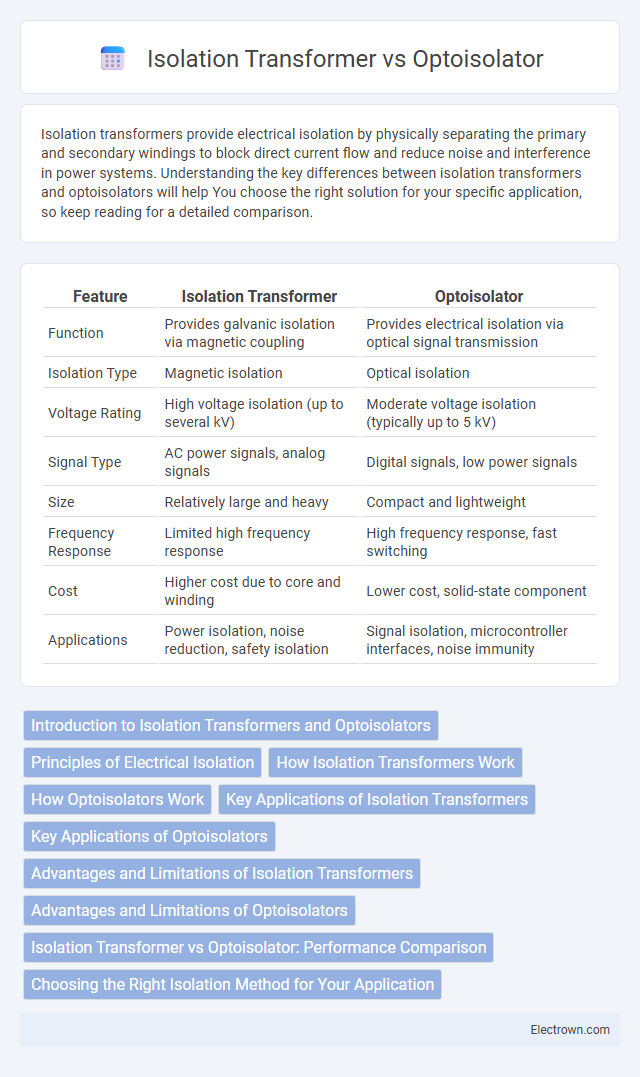Isolation transformers provide electrical isolation by physically separating the primary and secondary windings to block direct current flow and reduce noise and interference in power systems. Understanding the key differences between isolation transformers and optoisolators will help You choose the right solution for your specific application, so keep reading for a detailed comparison.
Table of Comparison
| Feature | Isolation Transformer | Optoisolator |
|---|---|---|
| Function | Provides galvanic isolation via magnetic coupling | Provides electrical isolation via optical signal transmission |
| Isolation Type | Magnetic isolation | Optical isolation |
| Voltage Rating | High voltage isolation (up to several kV) | Moderate voltage isolation (typically up to 5 kV) |
| Signal Type | AC power signals, analog signals | Digital signals, low power signals |
| Size | Relatively large and heavy | Compact and lightweight |
| Frequency Response | Limited high frequency response | High frequency response, fast switching |
| Cost | Higher cost due to core and winding | Lower cost, solid-state component |
| Applications | Power isolation, noise reduction, safety isolation | Signal isolation, microcontroller interfaces, noise immunity |
Introduction to Isolation Transformers and Optoisolators
Isolation transformers provide galvanic isolation by physically separating the input and output windings, effectively blocking direct current flow while allowing energy transfer via magnetic coupling. Optoisolators, also known as optocouplers, use light signals to transmit electrical signals between isolated circuits, ensuring signal isolation with minimal electrical connectivity. Both components are essential in protecting sensitive electronics from voltage spikes, noise, and ground loops in various industrial and communication applications.
Principles of Electrical Isolation
Isolation transformers provide electrical isolation by magnetically coupling primary and secondary windings without a direct conductive path, enabling voltage transfer while blocking DC offsets and high-frequency noise. Optoisolators achieve isolation through an optical interface, converting electrical signals into light within an LED and then back to electrical signals via a photodetector, ensuring galvanic isolation. Both methods effectively prevent ground loops and protect sensitive circuits by isolating input and output stages, but transformers handle higher power levels while optoisolators are suited for signal-level isolation.
How Isolation Transformers Work
Isolation transformers work by magnetically coupling two separate circuits through a shared core, enabling electrical isolation while transferring AC power without a direct conductive path. They reduce noise, transient voltage spikes, and ground loop interference, enhancing safety and signal integrity in sensitive electronic applications. Your equipment benefits from this isolation by preventing electrical shock and minimizing disruptions caused by electrical noise.
How Optoisolators Work
Optoisolators work by transferring electrical signals using light, which provides electrical isolation between input and output circuits, protecting sensitive components from voltage spikes and noise. Inside an optoisolator, an LED emits light when an input signal is applied, and a photodetector on the output side detects this light to generate a corresponding electrical signal. You can rely on optoisolators for ensuring signal integrity and safety in communication between high-voltage and low-voltage sections of electronic systems.
Key Applications of Isolation Transformers
Isolation transformers are primarily used in medical equipment, power supplies, and industrial machinery to provide electrical isolation and protect sensitive components from voltage spikes and electrical noise. They play a critical role in ensuring safety by preventing electric shock and maintaining signal integrity in environments with high electromagnetic interference (EMI). Your equipment benefits from enhanced reliability and reduced risk of damage, especially in applications requiring stable isolation between the power source and load.
Key Applications of Optoisolators
Optoisolators are primarily used in digital communication interfaces to protect microcontrollers and sensitive electronics from high voltages by providing electrical isolation while allowing signal transfer. They are essential in switching power supplies, signal isolation in industrial automation, and in medical equipment to ensure patient safety. Their ability to transmit digital signals without physical contact makes them ideal for noise reduction and preventing ground loops in complex electronic circuits.
Advantages and Limitations of Isolation Transformers
Isolation transformers offer superior electrical isolation by using magnetic coupling to separate input and output circuits, which effectively blocks ground loops and reduces electrical noise in sensitive equipment. They provide high power handling capacity and can accommodate a wide range of voltages and frequencies, making them ideal for industrial and medical applications. Limitations include bulkiness, weight, and higher cost compared to optoisolators, along with limited frequency response and slower transient response times.
Advantages and Limitations of Optoisolators
Optoisolators offer excellent electrical isolation by using light to transfer signals, ensuring minimal interference and protecting sensitive circuits from high voltages. Their compact size and fast switching speed make them ideal for signal transmission in digital communication and microcontroller applications. You should consider limitations such as limited current handling capacity and potential signal distortion at high frequencies when choosing optoisolators for your design.
Isolation Transformer vs Optoisolator: Performance Comparison
Isolation transformers provide galvanic isolation and voltage transformation with high power capacity and efficiency, making them ideal for managing large electrical loads and reducing noise in power circuits. Optoisolators use light to transmit signals across an isolation barrier, offering excellent signal integrity and fast response times for low-power electronic communication and control applications. Your choice depends on whether you need high-voltage power isolation or precise signal isolation in electronic circuits.
Choosing the Right Isolation Method for Your Application
Selecting the appropriate isolation method depends on your application's requirements for signal integrity, noise reduction, and safety. Isolation transformers excel in providing galvanic isolation with power transfer, making them ideal for AC power systems and high-voltage environments. Optoisolators, offering electrical isolation through light signals, are better suited for low-level signal isolation and high-speed data communication, ensuring precise control without direct electrical connections.
Isolation transformer vs optoisolator Infographic

 electrown.com
electrown.com